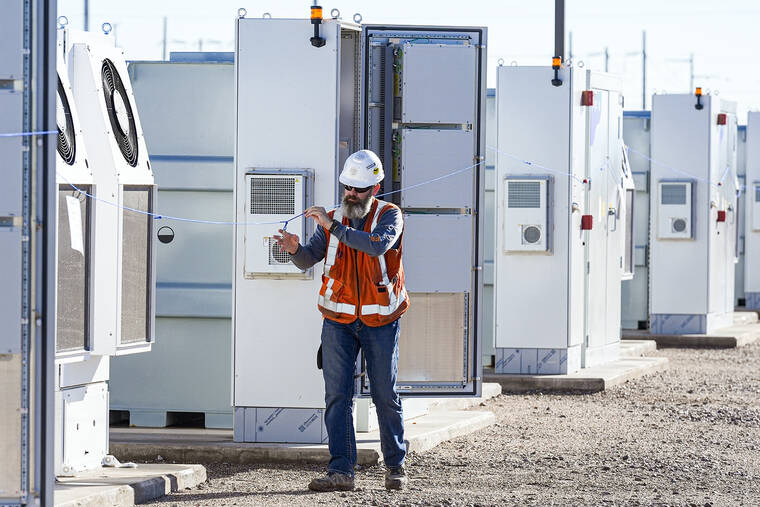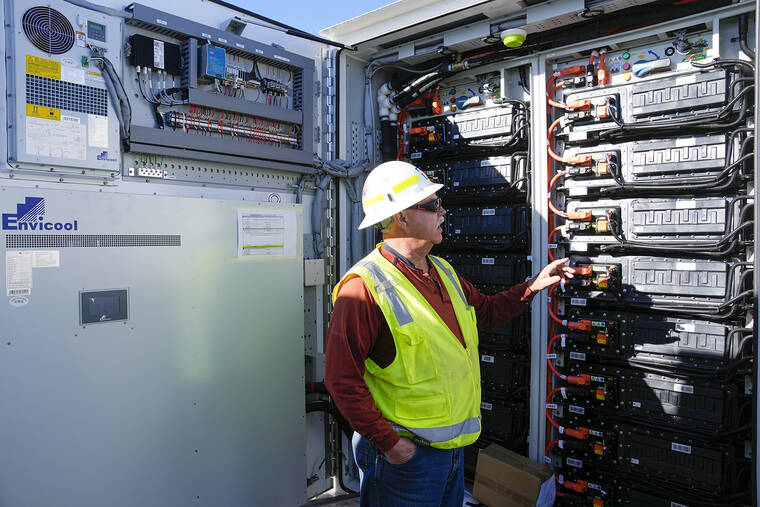Across the US, batteries and green energies like wind and solar combine for major climate solution
In the Arizona desert, a Danish company is building a massive solar farm that includes batteries that charge when the sun is shining and supply energy back to the electric grid when it’s not.
Combining batteries with green energy is a fast-growing climate solution.
“Solar farms only produce when the sun shines, and the turbines only produce when the wind blows,” said Ørsted CEO Mads Nipper. “For us to maximize the availability of the green power, 24-7, we have to store some of it too.”
The United States is rapidly adding batteries, mostly lithium-ion type, to store energy at large scale. Increasingly, these are getting paired with solar and wind projects, like in Arizona. The agencies that run electric grids, utility companies and developers of renewable energies say combining technologies is essential for a green energy future.
Batteries allow renewables to replace fossil fuels like oil, gas and coal, while keeping a steady flow of power when sources like wind and solar are not producing. For example, when people are sleeping and thus using less electricity, the energy produced from wind blowing through the night can be stored in batteries — and used when demand is high during the day.
Juan Mendez, a resident of Tempe, Arizona, gets power from local utility Salt River Project, which is collaborating with Ørsted on the Eleven Mile Solar Center. As a state senator, Mendez pushed SRP to move to renewable energies.
He thinks the power company is still investing too much in gas and coal plants, including a major expansion planned for a natural gas plant in Coolidge, Arizona, near the solar center.
“This solar-plus-storage is a good step, but SRP needs to do more to provide clean energy and clean up our air and help address climate change,” Mendez said.
The utility said it’s adding more renewables to its energy mix and recently pledged to zero out its emissions by 2050.
The U.S. has the second most electrical storage in the world, after China. In 2023, the U.S. added an estimated 7.5 gigawatts — 62% more than in 2022, according to the BloombergNEF and the Business Council for Sustainable Energy factbook. That amount can power 750,000 homes for a day and brings the total amount of installed capacity nationwide to nearly enough for 2 million homes for one day, according to BloombergNEF.
In the U.S., California leads in energy storage as it aggressively cuts greenhouse gas emissions. It has twice as much as any other state. Residential, commercial and utility-scale battery installations increased by 757% there over just four years, meaning there’s now enough to power 6.6 million homes for up to four hours, according to the California Energy Commission.
That’s partly because in 2013, the California Public Utilities Commission told utilities to buy energy storage with a target to be met by 2020. Since then, power companies have continued to add more batteries to help the state meet clean electricity requirements.
Southern California Edison is one utility adding thousands of hours of energy storage. It is putting in solar-plus-batteries to replace some power plants that burn natural gas and would typically supply electricity in the evening.
“If it’s just clean and not reliable, you really don’t have anything,” said William Walsh, vice president for energy procurement and management. “We need both.”
In California, batteries proved their value in September 2022, as the West was experiencing a long heat wave that sent temperatures into the triple digits. Electricity demand reached the highest the state had ever seen on Sept. 6, 2022, as people cranked up air conditioners.
Walsh credits the batteries added to the grid between 2020 and 2022 with helping to avoid blackouts. Two years earlier, there were rolling electricity outages in California during a similar extreme heat wave.
Texas has the second-most battery storage after California. Last month, Schneider Electric announced it’s teaming up with energy company ENGIE North America on solar and battery systems in Texas to get closer to the French multinational’s 100% renewable energy goal in the U.S. and Canada. Before the Inflation Reduction Act, a major climate law passed in 2022, the deal and the necessary $80 million investment would not have been possible, said Hans Royal, Schneider Electric’s senior director for renewable energy and carbon advisory.
Royal is advising other global Fortune 500 companies it works with to get into the market.
“The industry needs that, the grid needs it,” said Royal.
Back in Arizona, Ørsted’s Eleven Mile Solar Center covers 2,000 acres in rural Pinal County. It has 857,000 solar panels and more than 2,000 cubes that look like large shipping containers but contain battery modules.
Ørsted also has large solar and storage projects in Texas and Alabama, and in Europe.
When the Arizona facility opens this summer, most power from the solar farm will go to Facebook owner Meta’s data center in Mesa. The solar power not needed by Meta, in addition to the power stored in the batteries, will go to the local utility’s customers. The new batteries can ensure power to roughly 65,000 homes during peak hours of demand.
“What I think is exciting is just how rapidly this market is moving,” said Yayoi Sekine, head of energy storage at BloombergNEF.



